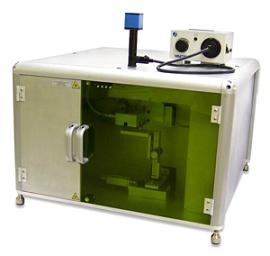LAMPS (Laser Assisted Microwave Plasma Spectroscopy), developed in conjunction with Envimetrics, represents a huge leap forward in LIBS technology. 
LAMPS features a specially designed microwave cavity to enhance plasma discharge, thereby increasing sensitivity for most potential analytes. Also enhanced are emission line stability and reproducibility, leading to better quantification results. Applications for a variety of diverse analytes requiring greater sensitivity and less ablative sample imprint are now made possible with LAMPS. |
|
LAMPS vs. LIBS Technology
Current LIBS technology permits qualitative analysis of a solid or liquid sample by ablating a minute portion of it, then analyzing the resulting plasma. LAMPS takes this a step further by employing a special microwave cavity. The plasma is injected into this cavity where it reacts with free electrons, greatly increasing sensitivity and producing better line stability and reproducibility. A lower power 50 mJ laser is used in the LAMPS, resulting in less ablation imprint to the sample and greater sensitivity.
LAMPS Components
Spectrometers -- The key to LIBS and LAMPS measurements is the ability to acquire high resolution spectra over a broad wavelength range of a transient event. This is accomplished by coupling 7 HR2000+ spectrometers into one system. Each spectrometer covers ~100-140 nm typically starting at 200nm for Channel A and ending with 980nm for Channel G.
Systems may be configured to start below 200 nm and with fewer channels for element-specific applications. Optical resolution is ~ 0.1nm FWHM. Pixel resolution is ~ 0.05 nm/pixel. In a 7-channel system, there are 14,336 pixels acquiring synchronous spectra. The detector integration time can be as low as 1 ms, and the maximum data transfer rate to the PC is about 500 spectra (14,336 values) per second over the USB 2.0 port.
Sample Chamber -- Provides critical eye safety by using laser safety shielding and safety interlocks on the door. The sample stage is a manual x, y and z positioner, with internal LED illumination for sample positioning. A fiber bundle, inserted inside the microwave cavity, is constructed with a special dielectric tip so that no metals are introduced into the cavity.
The next release will feature a redesign of the power supply so that it will be housed inside the sample chamber, weigh less, and will sustain plasmas greater than 2 ms. CE certification is pending the release of this next generation power supply.
Laser -- We provide Quantel's 50 mJ CFR Pulsed Nd:YAG Laser with our LAMPS system. The CFR design is especially rugged as both resonator mirrors are on the same rigid metal plate. The laser is mounted to the sample chamber and aligned to the focusing optics. A 100 mm lens with manual z-axis control permits focusing or allows defocusing of the laser for better plasma uniformity.
Software – OOILIBS operating software provides control of the lasers; has user-programmable delay for the Q switch; acquires, plots and saves spectra; and provides a spectral line library and correlation function for identification of peaks.
Spectra can be exported to Excel. Application-specific libraries of peaks can be loaded. You can zoom into a wavelength range to look for a peak in the library by double-clicking on the line in the table. Or, the correlation routine will match peaks to wavelengths in the library and rank the elements by how many of the emission lines it found. The user can set baseline and peak width filters for the search.
|

